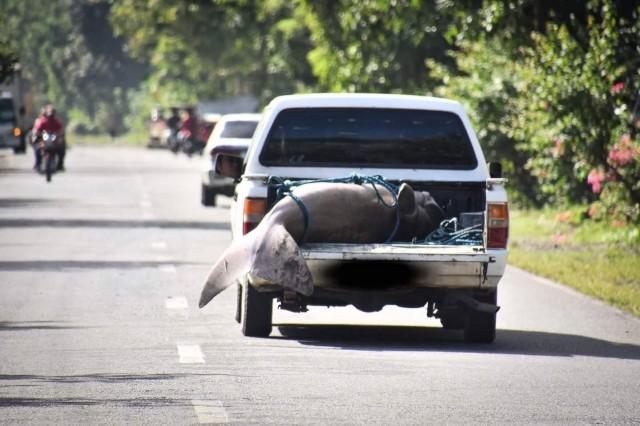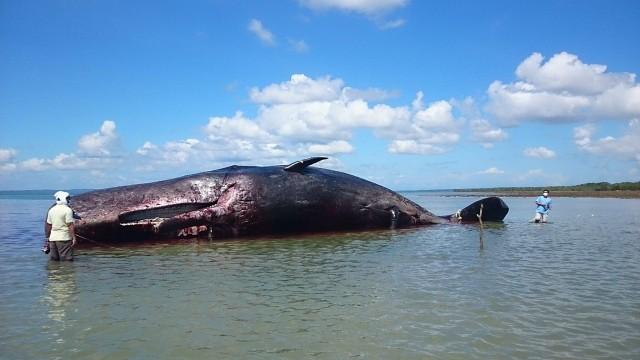Strandings confirm diversity in the country's marine mammals
In the last five years marine scientists from the University of the Philippines - Diliman recorded the highest frequency of strandings in the country - 61 percent or 438 of 713 events recorded in the last 12 years.
While these strandings were alarming, they came with a silver lining.
There are no wide scale field surveys of Philippine marine mammals, but these strandings provided similar data, which validated the diversity of marine species and their potential distribution in the country. This information could be vital in conservation efforts.
For example, according to a study entitled “The Philippine Marine Mammal Strandings from 2005 to 2016”, the strandings proved the presence of 29 species of marine mammals - 28 cetaceans or dolphins, whales; and one sirenian or sea cow.

A dugong or sea cow found in Barangay Kayupo in Kiamba, Sarangani last March 1, 2017 was brought by personnel from the Bureau of Fisheries and Aquatic Resources to their office for the necropsy to determine the cause of death. PHOTO BY LGU KIAMBA, SARANGANI
Also, in terms of distribution, the waters off the disputed West Philippine Sea appear to harbor a diverse collection of these cetaceans.
This is based on the records from the provinces in the area: Ilocos Norte where experts noted the presence of 15 species, Ilocos Sur with 11, Pangasinan has 13 species, and Zambales with 15 species.
The study, conducted by UP Professor Lemnuel Aragones, biophysicist Honey Leen Laggui and marine biologist Apple Kristine Amor of the Marine Mammal Research and Stranding Laboratory, Institute of Environmental Science and Meteorology UP-D, also confirmed the following to be important marine mammal habitats:
- the West Philippine Sea, and the waters surrounding the Bicol Peninsula (including Quezon province) in Luzon;
- the Tañon Strait, the Sulu Sea, the Bohol Sea in the Visayas; and
- Sarangani Bay, the Davao Gulf, and the Mindanao Sea in Mindanao.
The Ilocos Region had the highest number of recorded stranded marine mammals in five consecutive years, from 2011 to 2015, among the regions. The region also had the second highest number of stranding events in 2016 next to the Bicol Region.
These regions had an average of 13 strandings per year.
Moreover, all four provinces of Region I were included in the top 20 provinces in terms of recorded strandings, making the area the “hottest hotspot” nationwide.
There were at least 16 cetacean species strandings recorded in the Ilocos Region.
Species commonly seen
A total of 29 marine mammal species, or 28 cetaceans plus the dugong, can be found throughout the Philippines and this was confirmed through the stranding records.
The most common species found stranded or beached are the spinner dolphins (Stenella longirostris) with 115 incidents on record, followed by the Fraser’s dolphin (Lagenodelphis hosei), Risso’s dolphin (Grampus griseus), the melon-headed whale (Peponocephala electra), Pantropical spotted dolphin (Stenella attenuata), dwarf sperm whale (Kogia sima), and the dugong (Dugong dugon).

A Sperm Whale was found stranded in Barangay Bangkuruhan, Calauag, Quezon province Feb. 17, 2015. PHOTO BY BFAR 4A
The largest marine mammal was the sperm whale (Physeter macropcephalus), one of which was beached in Barangay Bangkuruha, Calauag in Quezon province in February 2015.
The dugong and the Irrawaddy dolphin are, most likely, the two most endangered marine mammals in the country.
The main concern, the scientists warned, was that the dugong was the seventh most commonly stranded species among the 26 recorded species. There were 36 recorded dugong strandings from 2006 to 2016, which is equivalent to three strandings per year for the last 11 years.
“This is alarming as the estimated Potential Biological Removal (PBR) allowed for a robust dugong population is 100 individuals. This means that such a population could only sustain one mortality outside of the normal as there is also a proportion of the population that dies annually,” the marine scientists explained in the study.
The PBR is the maximum number of animals, not including natural mortalities, that may be removed from a marine mammal stock while allowing that stock to reach or maintain its optimum sustainable population.
Aragones explained that a robust population of 500 can only afford one death outside of the normal mortalitues like old age or illness.
The Irrawaddy dolphin is in a similar state.
“It is important to note though that if we continue the status quo for these species (strandings), they would probably continue to slowly decline into their demise,” the scientists added.
Aragones told GMA News Online that the study was done to increase the awareness of coastal area residents on biodiversity conservation.
“First step usually 'yung increasing awareness ng public. Kaso, sa Pilipinas, may awareness naman na tayo in general, 'di ba? I think we should not just be contented with may awareness na mga tao o Pilipino,” he explained.
“We really have to harmonize our programs para di masira ang remaining habitats ng mga threatened, vulnerable at endangered species natin.” — DVM, GMA News
Part 3: Scientists note improved response to marine mammal strandings



